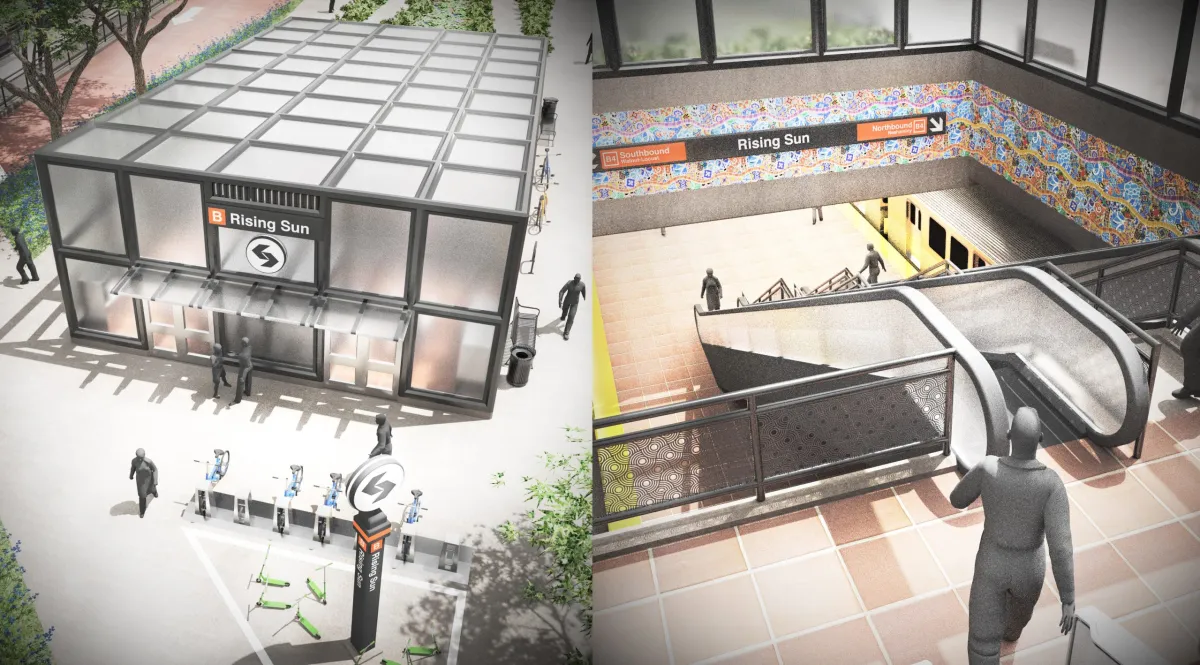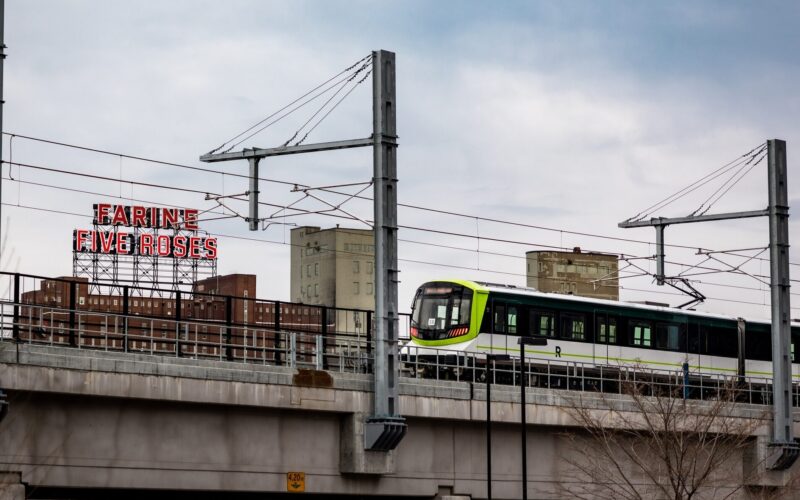
Renderings of the proposed Roosevelt Boulevard Subway in Philadelphia
For too long, the Federal Transportation Administration (FTA) and State Departments of Transportation (DOT) have provided funding to transit projects that aim to attract white-collar workers, rather than prioritizing the largely Black and brown riders who use and depend on reliable public transit. This could change with the once-in-a-generation investments available through the Biden Administration’s climate framework, Justice40, along with the Bipartisan Infrastructure Law (BIL), also known as the Infrastructure Investment and Jobs Act (IIJA). This marriage of unprecedented funding and an equitable framework provides an opportunity to transform transportation infrastructure, support the climate, and right historic injustices. Our network of transit advocates, organizers, and riders are calling on their local transit agencies and state DOTs to advance projects designed to improve the mobility of Black and Brown riders whose opportunities have been compromised by decades of transportation planning designed to primarily benefit more affluent white communities. In turn, we call on FTA to fund these projects.
Transformative Projects on the Horizon
Over the past year, TransitCenter has been surveying advocacy partners across the country about what capital projects could make the biggest impact for climate and equity, and we’re excited to finally make those results public! Some of these projects have been partially funded, though some haven’t received any funding. We would like to see money from the IIJA fully fund these projects. While there is more money available for transit capital projects than at any time in history, 80% of IIJA money will be funneled to state Departments of Transportation through the Federal Highway Administration. States typically spend this money on expanding highways, despite having the ability to spend it on other transportation needs. To meet climate and equity goals, we need to see states shift this money towards transit capital projects such as these.
Among the projects outlined in the spreadsheet linked above, three stand out for their potential to reshape transportation in their respective cities.
Los Angeles: Regional Connector – Bridging the Gaps
The Regional Connector project in Los Angeles, which opened in June of 2023, was designed to connect two transit lines, creating a frictionless journey for riders traveling across the region. Unfortunately, the three Regional Connector stations in downtown Los Angeles project opened without the approved plans for improving walking and biking connections in place. The essential first/last mile component of the project would dramatically impact the safety of passengers who use the system, and this downgrade signaled that cars are still the priority in Los Angeles. LA Metro and the FTA can right this misstep with future funding decisions, and advocates in Los Angeles are working to see them follow through on their promises to their constituents.
“The Broadway Station is an important center for the Latino community, and the Little Tokyo Station is a hub for the Japanese-American community in Los Angeles. Having good connectivity and safe streets; good walking and biking connections means that transit becomes a real option instead of defaulting to driving,” explains Eli Lipmen, Executive Director of Move LA.
New Orleans: East/West Bank BRT Project – Uniting Communities
New Orleans doesn’t currently have any bus rapid transit infrastructure. That could change with the proposed East/West Bank Bus Rapid Transit (BRT) project, which would provide a direct connection between the city’s east and west banks through a high-quality transit corridor. This initiative would not only provide a swift and reliable transportation option but also connect neighborhoods across New Orleans. Local authorities and transit agencies, along with community advocates, will be pivotal players in driving this project forward.
Courtney Jackson, the Executive Director of the local advocacy group Ride New Orleans, explains that “Bus Rapid Transit (BRT) implementation has the potential to fundamentally shift the transportation environment in New Orleans. It will improve outcomes for many residents by enhancing job, education, and amenity access. It has the potential to fundamentally shift the narrative of transit as an inferior alternative to vehicle ownership by demonstrating the utility of high-quality transit service implemented with supportive infrastructure. It also has the potential to enhance the walkability of downtown New Orleans by reducing personal vehicle travel to downtown, also leading to reduced congestion.”
For New Orleans’ transit riders, the BRT project could be life-changing, granting riders better access to job opportunities, healthcare services, and education.
Philadelphia: Roosevelt Boulevard Subway Project – A Long-Awaited Overhaul
The Roosevelt Boulevard Subway Project reimagines mobility in Northeast Philadelphia. The project envisions transforming the corridor into a thriving transportation hub, increasing the mobility of nearly 500,000 people. The idea for a Roosevelt Boulevard Subway has been around for over a century, but funding has been the primary barrier to realizing this vision. With federal support, this ambitious endeavor could finally come to fruition.
Roosevelt Boulevard is known as the “most pedestrian-hostile street in the city,” and the project could fundamentally alter the urban landscape for the better. According to Jay Arzu, a champion and advocate for the Roosevelt Subway, Northeast Philadelphia is cut off from transportation options. “The Northeast feels like it’s on an island because there isn’t a direct subway connection.” The Roosevelt Boulevard Subway would mean a safer and faster transportation route for Northeast residents. Arzu’s sentiment was echoed by Will Tung, a volunteer organizer with 5th Square, Philadelphia’s urban political action committee. Tung says that “the subway project would be transformative. It would cut commute times, make the street safer for pedestrians, and reduce pollution.”
Making the Dream a Reality
Each of these projects shares a common thread—making urban transportation work better for current riders and Black and brown communities. However, their success hinges on the allocation of IIJA funds and the collective commitment of local and federal stakeholders.
The impact of these projects goes beyond the improvement of transit systems. They offer hope for a future where public transportation is more than just a means of getting from point A to B. It’s a way to create equitable opportunities, reduce environmental impact, and foster stronger communities.
As advocates for just and accessible transportation, we call on state and local officials to seize this opportunity. The IIJA has laid the groundwork; now it’s time to take action. By directing funds to projects like the Regional Connector in Los Angeles, the East/West Bank BRT in New Orleans, and the Roosevelt Boulevard Subway Project in Philadelphia, we can correct past mistakes and allow communities across the country to thrive fully.
 On the Brink: Will WMATA’s Progress Be Erased by 2024?
On the Brink: Will WMATA’s Progress Be Erased by 2024?
The experience of being a WMATA rider has substantially improved over the last 18 months, thanks to changes the agency has made like adding off-peak service and simplifying fares. Things are about to get even better with the launch of all-door boarding later this fall, overnight bus service on some lines starting in December, and an ambitious plan to redesign the Metrobus network. But all of this could go away by July 1, 2024.
Read More On Track for Success: Decoding Montreal’s REM Model for Efficient Transit Projects in the U.S
On Track for Success: Decoding Montreal’s REM Model for Efficient Transit Projects in the U.S
Why is it so difficult to build subway and light rail projects in America? Every week there’s a new story about an American transit project that is behind schedule, over budget, or “paused”. Montreal’s Réseau express métropolitain (REM) stands out as a recent North American project that has begun to address some of the challenges that have foiled so many others. What is REM getting right that other projects aren’t?
Read More